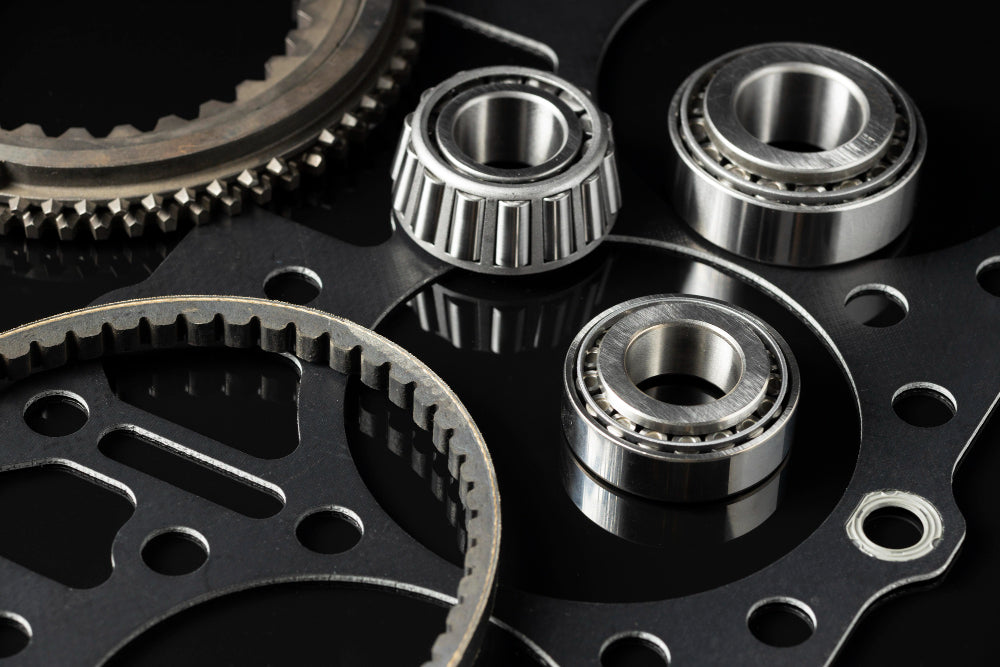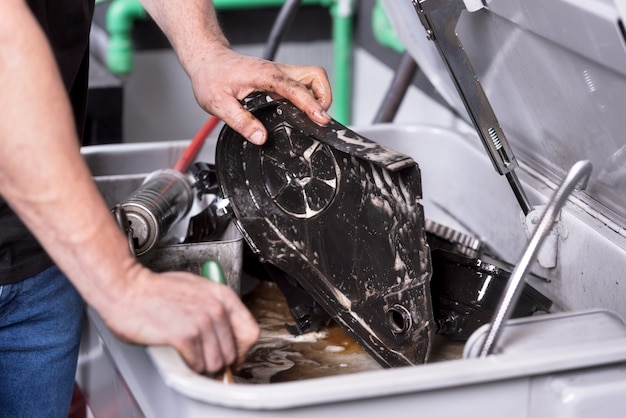
How Modern Automotive Parts Washers Benefit the Environment
Share
In automotive engineering, where every nut, bolt, and gear plays a crucial role, maintaining pristine parts isn't just a suggestion; it's a necessity. After all, clean parts mean smooth performance and a longer vehicle lifespan.
But here's the catch: the traditional methods we use to clean automotive parts aren't exactly friendly to our environment and health. However, in recent years, the automotive industry has witnessed a transformative shift toward modern automotive parts washers that improve cleaning efficiency and significantly reduce their environmental impact.
This article delves into the advantages of these innovative cleaning solutions, exploring how they benefit both the automotive industry and the environment. So, let’s dive in!

Traditional Automotive Parts Cleaning Methods
For many years, traditional methods have been used to clean automotive parts effectively. The most prominent ones include the following:
Solvent Cleaning
Solvent-based cleaning involves using chemical solvents, such as mineral spirits, kerosene, or acetone, to dissolve and remove grease, oil, and other contaminants from automotive parts.
This method is effective, but it raises concerns about environmental and health hazards due to the release of volatile organic compounds (VOCs). These chemicals can cause skin or respiratory irritation for those working with the solvents.
Manual Scrubbing
Another conventional method involves manually scrubbing parts using brushes, rags, or wire brushes. Technicians would physically clean away dirt and grime from the surface of the parts.
While this method allows for precision cleaning, it can be time-consuming and labor-intensive, and it might not effectively clean hard-to-reach areas.
Steam Cleaning
Steam cleaning employs high-temperature water vapor to remove contaminants from parts. The heat and pressure of the steam helps to loosen and dislodge dirt, grease, and grime.
This method is environmentally friendly since it doesn't require harsh chemicals. However, it might only be suitable for some types of parts and can be less effective for stubborn deposits.
Sandblasting
Sandblasting, also known as abrasive blasting, involves using compressed air to propel abrasive materials like sand or beads against the surface of the parts. This method is excellent for removing rust, paint, and stubborn deposits.
However, it can alter the surface texture and damage delicate parts if not performed carefully.
Vapor Degreasing
Vapor degreasing uses a solvent in vapor form to remove contaminants from parts. The parts are suspended above the solvent, and the vapors condense on the surface, carrying away dirt and grease.
This method is efficient and can be automated, but it raises concerns about environmental and health risks associated with solvent use.

Advantages of Modern Automotive Parts Washers
Modern automotive parts washers address the shortcomings of traditional cleaning methods. These tools utilize advanced technologies, automation, and precision cleaning techniques to achieve superior cleaning. As a result, they significantly reduce manual labor and minimize exposure to harmful chemicals.
One notable aspect of modern washers is their versatility. They are available in various forms, including aqueous-based systems and ultrasonic cleaning technologies.
Aqueous-based Cleaning
Aqueous cleaning involves using water-based solutions combined with detergents and sometimes additives to clean automotive parts. This method is considered more environmentally friendly compared to solvent-based cleaning.
Here are some advantages of an aqueous-based automotive parts washer:
- It minimizes the use of hazardous chemicals and reduces VOC emissions.
- The aqueous combines with detergents effectively dissolve and remove many contaminants, including oil, grease, dirt, and grime.
- Aqueous cleaning is generally gentle on various materials, including metals, plastics, and rubber, minimizing the risk of damage to parts.
- Unlike solvent-based methods, aqueous cleaning eliminates the risk of fire or explosion associated with flammable solvents.
- This method can be easily automated, leading to improved consistency, reduced labor costs, and enhanced throughput in large-scale operations.
Ultrasonic Cleaning
In this cleaning, an ultrasonic automotive parts washer produces high-frequency sound waves. These waves generate microscopic bubbles in a cleaning solution, which implode near the surface of the part being cleaned, dislodging dirt and contaminants.
Currently, Sonic Soak is the best ultrasonic cleaner in the market. This automotive parts washer is a compact, portable device that removes dirt from the tiniest corners of vehicles.
Here are some perks of an ultrasonic cleaner for car parts:
- It requires minimal manual intervention and reduces the need for extensive labor.
- It typically uses water-based cleaning solutions instead of harsh chemicals, making it more environmentally friendly and reducing chemical waste.
- It is relatively quick, often requiring shorter cleaning cycles than other methods.
- It suits various materials, including metals, plastics, ceramics, and glass.
- The heat generation is minimal, reducing the risk of thermal damage to parts.
- The waste generation is less than other cleaning methods, making waste disposal more manageable.
- It can be easily integrated into automated systems for enhanced efficiency and productivity.
Impact on Waste Management
One of the most significant benefits of modern automotive parts washers is their positive impact on waste management. Traditional methods often generate substantial amounts of hazardous waste, such as spent solvents and contaminated water. This posed a threat to the environment and incurred high disposal costs for businesses.
However, a modern ultrasonic cleaner for car parts features closed-loop systems that emphasize waste reduction and resource efficiency. These systems continuously recycle, filter, and purify the cleaning solutions, enabling their reuse for an extended period.
As a result, waste generation is minimized, disposal costs are lowered, and the risk of contaminating water sources is substantially reduced.
Water Conservation
Water scarcity is a pressing global concern, and industries are under increasing pressure to adopt sustainable water management practices. Modern automotive parts cleaners play a vital role in conserving water resources.
Unlike traditional methods requiring copious amounts of water for cleaning, modern washers are designed to conserve water. They incorporate low-flow nozzles and efficient spray patterns that maximize cleaning efficiency while minimizing water usage.
Moreover, the recycling capabilities of closed-loop systems significantly reduce the overall water consumption of these washers. By embracing water-efficient technologies, automotive businesses can contribute to global water conservation efforts while benefiting from reduced operational costs.
Cost Savings and ROI
The best ultrasonic cleaner offers more than just environmental benefits. Instead, it also translates to substantial cost savings and a favorable return on investment (ROI).
While the initial investment in modern washers might be higher than traditional methods, the long-term operational advantages far outweigh the upfront costs. The closed-loop recycling systems lead to reduced expenditure on cleaning solutions and disposal fees, contributing to ongoing cost savings.
Furthermore, modern washers' enhanced cleaning efficiency and automation capabilities lead to reduced downtime and increased productivity. These factors combined contribute to a favorable ROI over the washer's lifespan.
Conclusion
The automotive industry is undergoing a profound transformation in parts cleaning. Modern automotive parts washers are at the forefront of this change, offering a revolutionary approach to cleaning that marries efficiency with environmental consciousness.
These washers not only improve cleaning outcomes and reduce labor requirements but also mitigate the environmental impact of the automotive sector. Through waste reduction, water conservation, and cost savings, modern washers align with the broader sustainable development goals.

